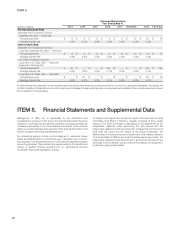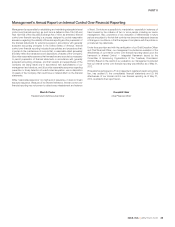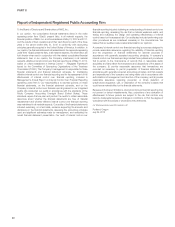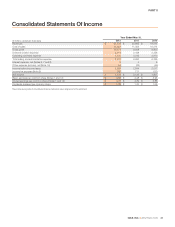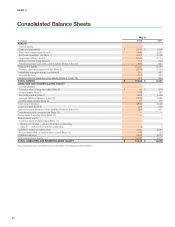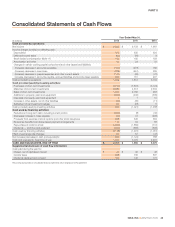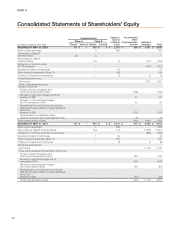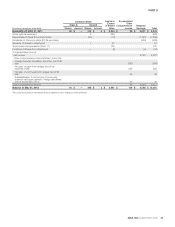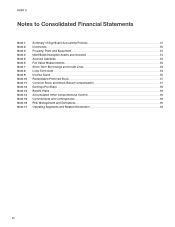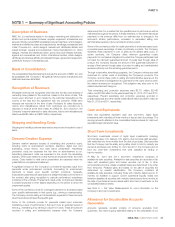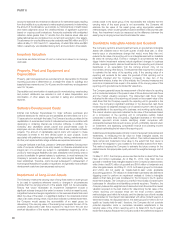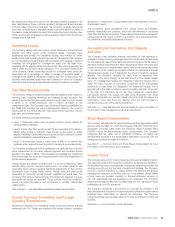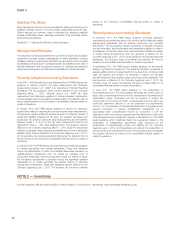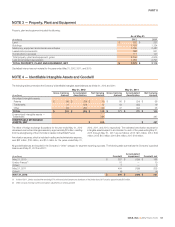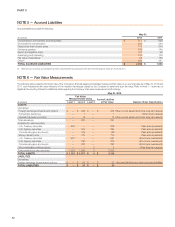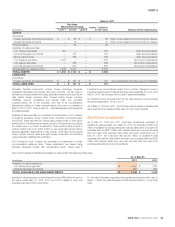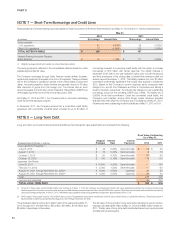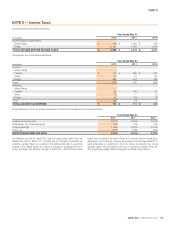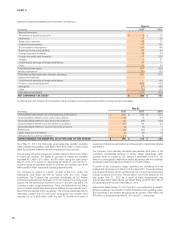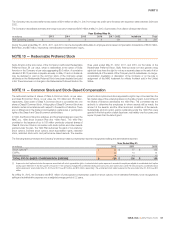Nike 2012 Annual Report Download - page 47
Download and view the complete annual report
Please find page 47 of the 2012 Nike annual report below. You can navigate through the pages in the report by either clicking on the pages listed below, or by using the keyword search tool below to find specific information within the annual report.
PART II
NOTE 1 — Summary of Significant Accounting Policies
Description of Business
NIKE, Inc. is a worldwide leader in the design, marketing and distribution of
athletic and sports-inspired footwear, apparel, equipment, accessories and
services. Wholly-owned NIKE subsidiaries include Cole Haan, which designs,
markets and distributes dress and casual shoes, handbags, accessories and
coats; Converse Inc., which designs, markets and distributes athletic and
casual footwear, apparel and accessories; Hurley International LLC, which
designs, markets and distributes action sports and youth lifestyle footwear,
apparel and accessories; and Umbro International Limited, which designs,
distributes and licenses athletic and casual footwear, apparel and equipment,
primarily for the sport of football (soccer).
Basis of Consolidation
The consolidated financial statements include the accounts of NIKE, Inc. and
its subsidiaries (the “Company”). All significant intercompany transactions and
balances have been eliminated.
Recognition of Revenues
Wholesale revenues are recognized when title and the risks and rewards of
ownership have passed to the customer, based on the terms of sale. This
occurs upon shipment or upon receipt by the customer depending on the
country of the sale and the agreement with the customer. Retail store
revenues are recorded at the time of sale. Provisions for sales discounts,
returns and miscellaneous claims from customers are recorded as a
reduction to revenue at the time of sale. As of May 31, 2012 and 2011, the
Company’s reserve balances for sales discounts, returns and miscellaneous
claims were $480 million and $423 million, respectively.
Shipping and Handling Costs
Shipping and handling costs are expensed as incurred and included in cost of
sales.
Demand Creation Expense
Demand creation expense consists of advertising and promotion costs,
including costs of endorsement contracts, television, digital and print
advertising, brand events, and retail brand presentation. Advertising
production costs are expensed the first time an advertisement is run.
Advertising placement costs are expensed in the month the advertising
appears, while costs related to brand events are expensed when the event
occurs. Costs related to retail brand presentation are expensed when the
presentation is completed and delivered.
A significant amount of the Company’s promotional expenses result from
payments under endorsement contracts. Accounting for endorsement
payments is based upon specific contract provisions. Generally,
endorsement payments are expensed on a straight-line basis over the term of
the contract after giving recognition to periodic performance compliance
provisions of the contracts. Prepayments made under contracts are included
in prepaid expenses or other assets depending on the period to which the
prepayment applies.
Some of the contracts provide for contingent payments to endorsers based
upon specific achievements in their sports (e.g., winning a championship).
The Company records selling and administrative expense for these amounts
when the endorser achieves the specific goal.
Some of the contracts provide for payments based upon endorsers
maintaining a level of performance in their sport over an extended period of
time (e.g., maintaining a top ranking in a sport for a year). These amounts are
recorded in selling and administrative expense when the Company
determines that it is probable that the specified level of performance will be
maintained throughout the period. In these instances, to the extent that actual
payments to the endorser differ from our estimate due to changes in the
endorser’s athletic performance, increased or decreased selling and
administrative expense may be recorded in a future period.
Some of the contracts provide for royalty payments to endorsers based upon
a predetermined percentage of sales of particular products. The Company
expenses these payments in cost of sales as the related sales occur. In
certain contracts, the Company offers minimum guaranteed royalty
payments. For contractual obligations for which the Company estimates it will
not meet the minimum guaranteed amount of royalty fees through sales of
product, the Company records the amount of the guaranteed payment in
excess of that earned through sales of product in selling and administrative
expense uniformly over the remaining guarantee period.
Through cooperative advertising programs, the Company reimburses retail
customers for certain costs of advertising the Company’s products. The
Company records these costs in selling and administrative expense at the
point in time when it is obligated to its customers for the costs, which is when
the related revenues are recognized. This obligation may arise prior to the
related advertisement being run.
Total advertising and promotion expenses were $2,711 million, $2,448
million, and $2,356 million for the years ended May 31, 2012, 2011 and 2010,
respectively. Prepaid advertising and promotion expenses recorded in
prepaid expenses and other assets totaled $309 million and $291 million at
May 31, 2012 and 2011, respectively.
Cash and Equivalents
Cash and equivalents represent cash and short-term, highly liquid
investments with maturities of three months or less at date of purchase. The
carrying amounts reflected in the consolidated balance sheets for cash and
equivalents approximate fair value.
Short-Term Investments
Short-term investments consist of highly liquid investments, including
commercial paper, U.S. treasury, U.S. agency, and corporate debt securities,
with maturities over three months from the date of purchase. Debt securities
that the Company has the ability and positive intent to hold to maturity are
carried at amortized cost. At May 31, 2012 and 2011, the Company did not
hold any short-term investments that were classified as trading or
held-to-maturity.
At May 31, 2012 and 2011, short-term investments consisted of
available-for-sale securities. Available-for-sale securities are recorded at fair
value with unrealized gains and losses reported, net of tax, in other
comprehensive income, unless unrealized losses are determined to be other
than temporary. Realized gains and losses on the sale of securities are
determined by specific identification. The Company considers all
available-for-sale securities, including those with maturity dates beyond 12
months, as available to support current operational liquidity needs and
therefore classifies all securities with maturity dates beyond three months at
the date of purchase as current assets within short-term investments on the
consolidated balance sheets.
See Note 6 — Fair Value Measurements for more information on the
Company’s short-term investments.
Allowance for Uncollectible Accounts
Receivable
Accounts receivable consists primarily of amounts receivable from
customers. We make ongoing estimates relating to the collectability of our
NIKE, INC. Š2012 Form 10-K 47



